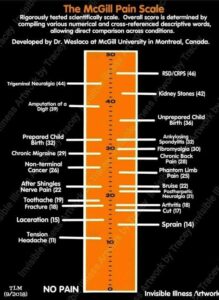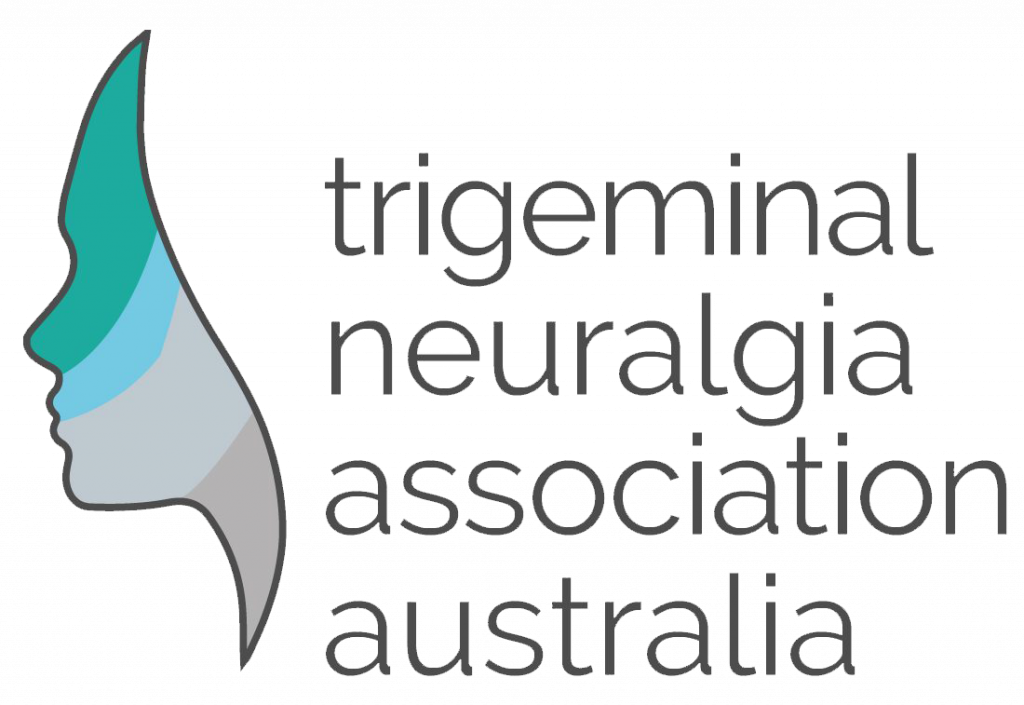The diagnosis of trigeminal neuralgia is a day people living with the condition will always remember and when they may have to consider a disability support pension. Prior to the diagnosis each person would have gone through extreme pain, confusion, misdiagnosis, disbelief, isolation, mental health breakdown, extreme anxiety, loss of hope and isolation.
Then you are finally diagnosed and prescribed medications with nasty side effects which may impact your ability to work, drive, function, deal with complex thought and even speaking.
Sometimes others need a visual understanding for the level of pain generated by trigeminal neuralgia. The McGill Pain Scale classifies the pain level higher that planned and unplanned childbirth

Even if you are covering by incapacity insurance, the fact that TN is so poorly understood within the Insurance Sector you are sure to be stone walled because ” We don’t have a classification for Trigeminal Neuralgia” etc.

So the next avenue to navigate is the Federal Disability Pension. That should be a simple process……. unfortunately not so.
There is no classification for Chronic Pain, so you are assessed against a particular table which may or may not match your impairment. You are required to score 20 points from the table you are assessed against and you must have a full medical history folder, proof of condition from your medical practitioners etc.

The following section was prepared by Pain Australia Org
The Disability Support Pension and Chronic Pain
You may be eligible for the Disability Support Pension (DSP), but you can’t get the DSP just on a chronic pain diagnosis alone.
The current 2011 Impairment Tables have made getting the DSP very difficult and new rules that came into effect 1 July 2015 have made it still more difficult. It may take up to a year to get a decision from the Department of Human Services (DHS). The document being referred to here is: Social Security (Tables for the Assessment of Work-related Impairment for Disability Support Pension) Determination 2011.
Important Information
• The diagnosed condition you have will not get you the DSP. It is the Impairment you have as a result of the condition that affects your Function at work that is rated for points.
• The Impairment Tables are the most critical information for understanding how the DHS assesses your claim. These 15 tables are the guidelines for government assessors to assign points. Get help if necessary to understand the Tables. Get it right first time rather than be denied and have to appeal. Read all Parts of the Tables.
• None of the tables deals specifically with pain. Chronic pain is a condition and if it has been diagnosed then any impairment related to chronic pain will be assessed using the relevant
Table for the area of function affected—physical, intellectual or psychiatric.
• To be granted the DSP you need to get a minimum of 20 points from only 1 Table (Function). 20 points is a Severe Impairment rating. Impairment means a loss of functional capacity affecting a person’s ability to work that results from the person’s condition. The Impairment Tables are based on Functions rather than Diagnosis. Functions can be activities, abilities, symptoms and limitations.
• A combination of Impairment Tables to make up the 20 points is not possible.
Eligibility
• You must have had the condition at least two years; and
• the condition causing impairment has to be permanent (interpreted as continuous or unrelenting); and
• the impairment is likely to continue more than two years; and
• you must be assessed as having a physical, intellectual or psychiatric impairment (or blindness); and
• the condition must be fully diagnosed, fully treated and fully stabilised (get clarification if necessary).
Advice
• Speak to the DHS first so you know what is involved. A face-to-face conversation is best. Ask questions if anything is unclear and/or take someone with you.
• When you prepare your claim provide as much medical information as possible. If you have a number of chronic pain conditions with functional impairments focus on the condition/s that have the highest level of impairment.
• If you are on Newstart, unable to work and intend to claim the DSP, your GP can give you a three-month Medical Certificate, which exempts you from work/job seeking. If appropriate you can continue to get the three-monthly certificates. (You will lose Program of Support credits—refer DHS).
DSP Process
If your claim is accepted you will be contacted for a Job Capacity Assessment (JCA). Clarify that it will be a face-to-face interview, as a video conference is difficult. A Disability Medical Assessment by a government doctor will be required if the JCA gives you 20 points or more.
Don’t Do it Alone
This is a hard and emotional process. There are Social Workers at most Centrelink offices for support, information and short-term counselling if needed but you will need to ask for one.
The following Section has been taken from the Federal Government Website
Impairment rating
We assess your impairment as part of the general medical rules for Disability Support Pension (DSP).
Your impairment is how your disability or medical condition affects your ability to function each day.
How we use Impairment Tables
We assess your impairment using the Impairment Tables on the Social Services website. These Tables are part of social security law for DSP.
New Tables started from 1 April 2023 and are used to assess DSP claims submitted on, or after this date. Read more about the new Impairment Tables on the Federal Register of Legislation website.
The previous Tables still apply to DSP claims submitted before 1 April 2023. This includes reviews and appeals for a DSP claim submitted before 1 April 2023.
Details about the review of the DSP impairment Tables and a summary of changes are available on the Department of Social Services website.
We use the Tables to:
- assess any conditions you have that are diagnosed, reasonably treated and stabilised
- assess the effect those conditions have on your ability to work
- assign impairment ratings.
Some Impairment Tables have specific diagnosis and specialist medical evidence requirements.
How the impairment rating affects your claim
The impairment rating helps us assess if you meet the general medical rules for DSP.
To meet these rules, you need to have either:
- an impairment rating of 20 points or more on a single Impairment Table
- 20 points or more in total on more than one Impairment Table and meet the Program of Support rules.
If you meet the impairment rating for DSP, we also assess your ability to work.
If we assess your total impairment rating is less than 20 points, you won’t be eligible for DSP.
Example of not meeting the 20 point impairment rating
Following a boating accident, Anne’s leg was amputated. During her rehabilitation, Anne was fitted with a prosthetic limb. Anne can walk without help from another person, though sometimes she uses a walking stick when she gets tired. Anne applies for DSP after she loses her job.
Our assessor uses Anne’s medical evidence to determine that Anne’s condition is diagnosed, reasonably treated and stabilised. The assessor then considers the impact of Anne’s condition against the descriptions in the Impairment Tables.
Anne can walk independently and use public transport without help from another person. As a result, she doesn’t get 20 points under the Impairment Tables. Anne can’t get DSP.
Anne can get help to find or retrain for a suitable job. We refer Anne to Disability Employment Services, which help people with disability, illness or injury find and keep a job.
Assessing your ability to work
We assess your ability to work as part of general medical rules for Disability Support Pension (DSP).
Page last updated: 24 August 2023.


